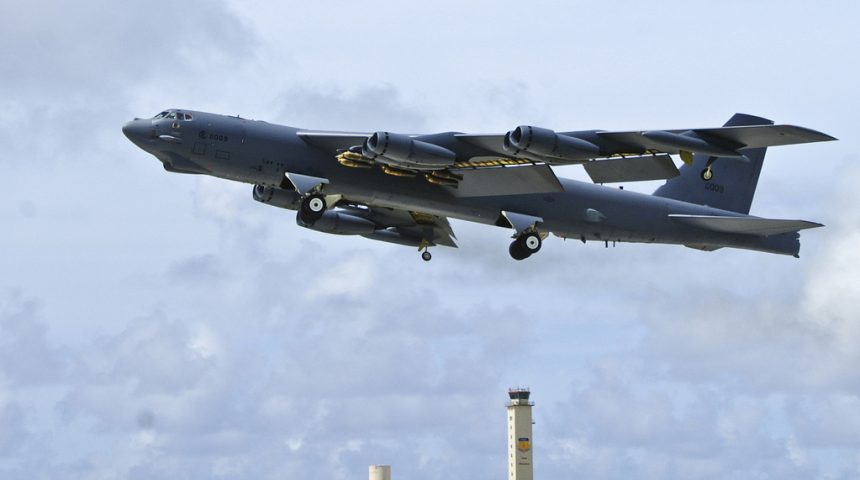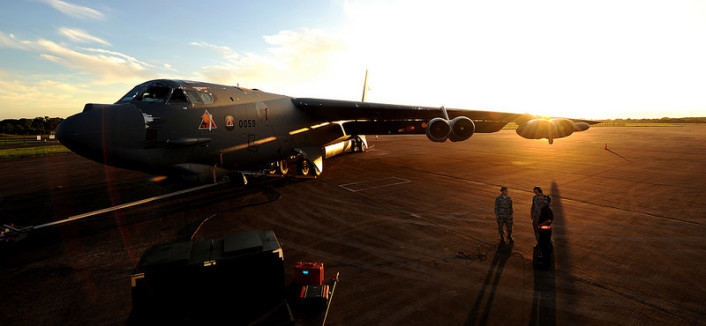The little but decisive role played by B-52s during Kosovo crisis.
The iconic U.S. Air Force B-52 Stratofortress strategic bomber, symbol of the U.S. nuclear deterrence, has taken part in all the wars fought by Washington in the last 50 years (Syria, so far, is the only exception).
Among the conflict that saw the involvement of the “BUFFs” there is also Operation Allied Force, the air campaign conducted against Serbia in 1999.
As recalled by Bill Yenne in his book “B-52 Stratofortress The Complete History of the World’s Longest Serving and Best Known Bomber” the first calls for NATO to intervene with military airpower in response to Serbian President Slobodan Milosevic’s campaign of ethnic cleansing of Kosovar Albanians, date back to the summer of 1998.
Then, on Oct. 10 of the same year, the US Secretary of Defense William Cohen ordered the deployment of six B-52H from the 2nd Bombardment Wing at Barksdale Air Force Base to RAF Fairford in the United Kingdom.
Two more Stratofortresses arrived at the UK base on Feb. 22, 1999 as part of the military build-up in Europe in anticipation of a war in the Balkans which would involve strategic bombers as well as several tactical planes, forward deployed at several airbases located in Italy and few other European countries. By the end of the war, 25 B-52s belonging to the 2nd Bomb Wing from Barksdale Air Force Base and 5th Bomb Wing from Minot Air Force Base would take part in the air strikes.
The aircraft were annexed to the 2nd Air Expeditionary Group that included B-1B Lancers from the 28th Bomb Wing from and KC-135s of the 22nd Air Refueling Squadron, Mountain Home Air Force Base.
Operation Allied Force was launched on the night of Mar. 24.
Among the 250 U.S. combat planes that conducted the first air strikes there were also seven B-52s carrying AGM-86C Conventional Air Launched Cruise Missiles (CALCMs) aimed at the Serbian IADS (Integrated Air Defense System). Between 30 and 50 air-launched cruise missiles, targeted Serbian air defense sites, during the opening stages of the air campaign.
Initially, the B-52s followed an 8-hour round trip route that brought them above Spain and central Mediterranean Sea before reaching the launch area circumnavigating Southern Italy. Then, they were reserved special corridors across Central Italy that made the missions sensibly shorter, with a good impact on the crew and airframes’ turn over.
As soon as most of Serbian air defenses were made harmless, the B-52 transitioned from stand-off weapons to general purpose bombs and cluster bomb units, dropped on Serbian army positions and staging areas.
Two more B-52Hs arrived from the 5th Bombardment Wing at Minot AFB in North Dakota, to Fairford on Apr. 29: like the Viet Cong and the Iraqi Republican Guard, Milosevic would soon discover the tremendous power of a B-52’s bomb load is a horrible thing to endure, and experiencing it firsthand is a horrible way to make that discovery.
Leaflets written in Serbian, that warned bombardments by B-52s, were also dropped over the Kosovo capital, Pristina. As reported by Yenne, the BBC translated their warning message: “The Yugoslav Army forces are warned to leave Kosovo, because NATO is now using B-52 bombers to cast Mk 82 bombs, weighing 225 kilograms each… Every B-52 bomber can carry more than 50 such bombs. These aircraft will be after you until they drive you out of Kosovo… and prevent you from committing atrocities… If you want to survive and see your families again, you should abandon your units and firearms.”
As the amout of air strikes peaked between the end of May and beginning of June, some of the most persuasive missions of the war were flown by the B-52s on the first weekend of June 1999 at a place on the Kosovo – Albania border called Mount Pastrik, where the KLA (Kosovo Liberation Army) was fighting a sizable Serbian army force.
The results of the raids were reported by several networks around the globe such as the CNN which on Sunday, Jun. 6 stated that the NATO used B-52 bombers Saturday night into Sunday to strike areas in Kosovo, near its border with Albania. There was also military activity along the border between Albania and Kosovo.
Other B-52 strikes concentrated in an area near Gorshub, in Yugoslavia, just inside the border. The mountain plateau was also the scene of a day-long artillery and mortar battle between Yugoslav forces and KLA. Further details were added by the Reuters that on Wednesday, June 9, reported that a NATO B-52 bomber caught two Yugoslav Army battalions in the open after Serbia stalled on pulling its troops out of Kosovo . The B-52 dropped sticks of gravity bombs on the troop concentrations near the Kosovo – Albania border Monday, carpeting a hillside area where some 400 to 800 soldiers were estimated to have been in the field. Moreover the Reuters added that NATO military spokesman Gen. Walter Jerts confirmed that “heavy bombers had been diverted at short notice to attack troops in Kosovo.”
The same day Dana Priest of the Washington Post wrote that “at least a month ago, NATO commanders began using B-52s to herd troops on the ground into more open and vulnerable areas (because there are no NATO troops on the ground to do this). […] On Monday, a pair of B-52s and B-1Bs dropped 86 Mk 82s… on a concentration of several hundred Serb troops near Mt. Pastrik region.”
Few days after this air raid, on Jun. 10, NATO ratified the terms of an international peace plan and stopped the seventy-eight-day air campaign. Two days later as told once again by Dana Priest “Slobodan Milosevic unexpectedly capitulated…Milosevic signed an agreement allowing the invasion of 50,000 NATO soldiers – but as peacekeepers, not warriors.”
A great achievement, reached also thanks to the BUFF aircrews who played a small but vital part in Operation Allied Force.











